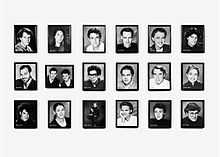David Robbins (artist)

David Robbins (born 1957 in Whitefish Bay, Wisconsin) is an artist and writer who was one of the first to investigate the art world's entrance into the culture industry.
His work reflects on the spectacle, the transformation of the position of the artist in the visual system, and areas of overlap between art, entertainment, and comedy. As an artist he is best known for his 1986 work entitled Talent, eighteen "entertainer's headshots" of contemporary artists including Cindy Sherman, Jeff Koons, Jenny Holzer, Allan McCollum and others, as well as The Ice Cream Social, a project comprising installations, performances, a novella, a TV pilot, and numerous other media that in its totality represents an emphatically American version of some of the exhibition strategies employed by artists associated with relational aesthetics. As a writer he is known for his essays about entertainment and comedy.
Career
After attending Brown University, Robbins was employed in the early 1980s by Andy Warhol, George Plimpton, and Diana Vreeland, during which years he educated himself about art by interviewing emerging artists such as Richard Prince, Jenny Holzer, Keith Haring, and Allan McCollum. Robbins began exhibiting his art in the mid-1980s in New York, where he was closely associated with the neo-conceptual Gallery Nature Morte.
In contrast to the Pictures generation (his immediate predecessors who maintained a critical distance from the mass advertising and entertainment imagery that fascinated them), Robbins pioneered an approach to art that unapologetically embraced entertainment culture.[1] His first solo exhibition, The David Robbins Show (1986) featured "guest" collaborators such as Richard Prince, Clegg & Guttman, and Jennifer Bolande.[2] He gained wider recognition for photographic works such as Talent and The Art Dealers’ Optical Tests (1987), which treated the art context as material for comedy.[3][4][5] He actively promoted what he termed the "comic object" -- an object made with sophisticated comic rather than aesthetic intent. In later works such as The German Reunification Public Sculpture Competition (1991) and The Ice Cream Social (1993–2008), which curator Hans Ulrich Obrist has cited as representing "an expanded exhibition model," Robbins looked at political content through a comic lens.[6][7][8] In other works of the same period, such as the Situation Comedies (1994–2003), he emptied his comedy of all narrative and topicality, creating objects that explored comedy as a subject in itself.
Robbins is also known for the theory and practice of what he refers to as "alternatives to art." Concrete Comedy is his term for a kind of non-fiction comedy of objects and gestures that surfaced in the early decades of the 20th century, first evidenced in the work of German comedian Karl Valentin and French artist Marcel Duchamp, and was subsequently recurringly manifested culture-wide, in fashion, architecture, music, film, television, art, advertising, and design.[9] In November 2006 Robbins' "Concrete Comedy" essay appeared in Artforum magazine.[10][11] From 1996-2006 he taught a course in the subject at The School of The Art Institute of Chicago, during which period he wrote Concrete Comedy: An Alternative History to Twentieth-Century Comedy, the first comprehensive consideration of materialist comedy. The book was published in 2011 by Pork Salad Press. His other "alternative to art," known as High Entertainment, argues for a category of imaginative production that balances art's emphasis on form-discovery with entertainment's emphasis on accessibility. Born of the new production and distribution opportunities of the digital era, High Entertainment encourages the "independent imagination" (Robbins prefers this term to "artist") to apply art's experimentalism to mainstream forms such as commercial film and television.[12]
Writing
Robbins was an early contributor to REALLIFE Magazine, Purple magazine, and Art issues. His books include Concrete Comedy; The Velvet Grind: Essays, Interviews, Satires 1983-2005, which collect several of his early interviews; a novella, The Ice Cream Social; High Entertainment; The Dr. Frankenstein Option; Foundation Papers from the Archives of the Institute for Advanced Comedic Behavior; and The Camera Believes Everything.
Video work
Video work includes Lift (2006), which screened at the New York Video Festival; The Ice Cream Social (2004), winner of the Sundance TV Lab competition; and Something Theater (2009–present), a broadcast television show created with Bobby Ciraldo and Andrew Swant.
References
- ↑ Salvioni, Daniella. (Review) Flash Art, September, 1986
- ↑ de Bruijne, Ellen. "The David Robbins Show," Metropolis M, October,1990
- ↑ “On Talent,” in Likeness: Artists' Portraits of Artists, CCAC/Wattis Institute, 2004
- ↑ Gasparina, Jill, “Le Cauchemar de Greenberg: Sur la massification de l’art contemporain,” Les Cahiers du Musee National d’Art Moderne, Centre Pompidou, Autumn, 2007
- ↑ Jones, Ronald, review, Artscribe International, November/December, 1987
- ↑ Obrist, Hans Ulrich, "Good Humor Man," Artforum, November, 2004
- ↑ Gilbert, Chris, “David Robbins: Ice Cream Social,” Trouble, #4, Spring 2004
- ↑ “Forming Fun: Hans Ulrich Obrist with David Robbins,” X-Tra, Summer 2007
- ↑ "Herr Karl Valentin," Art issues, April/May, 2000
- ↑ Robbins, David, “Concrete Comedy,” Artforum, November, 2004
- ↑ Grabner, Michelle,“David Robbins,” Frieze magazine, March 2001
- ↑ Interview with David Robbins,” Bad at Sports, 2007
External links
- Official Website
- ARTBOOK interview with David Robbins regarding his Concrete Comedy book
- High Entertainment online book
- David Robbins at the Internet Movie Database
- Artforum interview with Robbins regarding his Concrete Comedy concept
- Interview with Robbins regarding High Entertainment
- Interview with David Robbins regarding his television commercials for a Warhol show
- The Velvet Grind book
- Artforum article about David Robbins' Ice Cream Social
- Forming Fun Discussion between David Robbins and Hans Ulrich Obrist published in X-TRA : Contemporary Art Quarterly
|